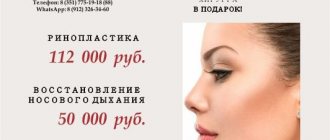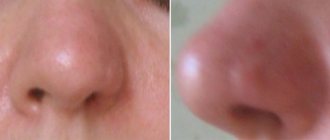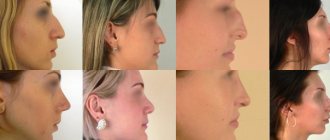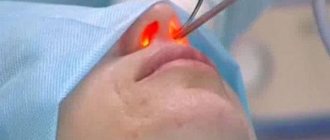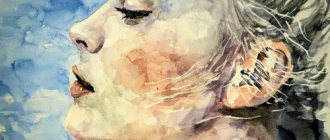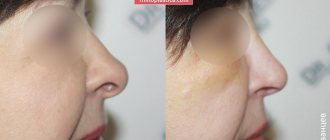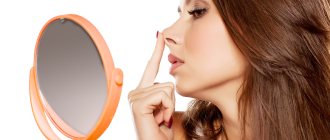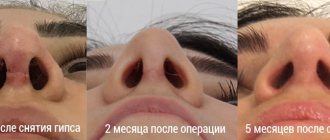Plastic surgery on the nose leads in the statistics of reconstructive and plastic surgery in terms of frequency of performance. With this operation, you can correct the shape and size of the outer part of the nose, treat pathological conditions, and reconstruct the organ after injury. The possibilities of modern medicine are so wide that the nose can be formed and restored even in its absence.
Sometimes plastic surgery is used only for the tip of the nose, if it is deformed, damaged, or has congenital features. This intervention does not affect the function of the organ and has a cosmetic effect.
Recently, most plastic surgeons perform rhinoplasty using the closed method - without the use of external incisions, through the mucous membrane of the nasal cavity. An open technique may be needed in particularly difficult cases, such as injuries.
Causes and consequences of a deviated septum
Deformations of the nasal septum are most often congenital and caused by genetic abnormalities. The problem is also caused by:
- nasal injuries (fractures, dislocations);
- the presence of cysts and polyps in the nasal cavity;
- swelling of the mucous membrane with vasomotor rhinitis;
- passion for fashionable procedures (piercing).
A deviated septum is dangerous due to many negative consequences - the inability to breathe freely, constant nasal congestion, deterioration of the sense of smell, dryness and itching, and nasal bleeding. If the cartilage is deformed, frequent colds, sinusitis, and headaches occur. Breathing becomes noisy, snoring appears at night.
If there is a deformed nasal septum, the body experiences oxygen starvation. This causes increased fatigue. Children with this disorder are prone to poor academic performance and retarded physical development. If the septum is deviated, the nostrils may differ in size.
Indications for rhinoseptoplasty
- Deformation of the nasal septum, leading to the development of chronic ENT diseases (allergic and chronic rhinitis, inflammation of the sinuses, difficulty breathing);
- Dissatisfaction with the aesthetics of the shape of the nose (congenital or acquired asymmetry, deformation of the nasal septum);
- Perforation of the nasal septum (a through hole in the bone or cartilaginous part of the septum);
- Severe snoring, polyps, sinusitis caused by a deviated nasal septum;
- Injuries to the nose (often fractures), due to which cartilaginous growths appeared in places of “adhesions”, which led to aesthetic imperfections and functional impairments.
Contraindications for septoplasty
It is impossible to prevent a deviated septum. The only way to eliminate this pathology is septoplasty. There are no other methods to effectively solve the problem.
Septoplasty is a serious surgical procedure performed in different ways and requiring special preparation. The procedure has certain contraindications:
- the presence of tumors in the nose;
- diabetes;
- bleeding disorders;
- high blood pressure;
- exacerbation of chronic diseases.
The method is not used during pregnancy and menstruation in women. The operation is intended for adult patients and is therefore not performed on people under 18 years of age.
How is the operation performed?
Rhinoseptoplasty of the nose involves a large amount of surgical intervention, therefore, as a rule, it is performed under general anesthesia.
Based on the nature of the problems, rhinoseptoplasty is divided into functional and reconstructive:
- Functional rhinoseptoplasty (indicated for congenital defects of the nasal septum);
- Reconstructive rhinoseptoplasty (indicated for acquired deviated septum (trauma, ENT diseases).
Based on the symptoms and severity of the problem, at the stage of preparation for the operation, the rhinosurgeon determines how the operation will be performed: by closed or open rhinoseptoplasty.
Closed rhinoseptoplasty is performed endonasally, through incisions inside the nasal cavity
Closed rhinoseptoplasty is performed endonasally, exclusively through incisions inside the nasal cavity. This method is most often used in functional rhinoseptoplasty, and with the help of open access, the surgeon corrects the nasal septum that is deformed due to injury or a previously unsuccessful operation.
The duration of the rhinoseptoplasty operation can reach 3-4 hours. At the end of the operation, the doctor inserts special hemostatic tampons - turundas - into the patient’s nasal passages, and the outer part of the nose is fixed with a plaster cast.
Preparation, progress of the operation
In order for the operation to be successful, the patient must prepare for it correctly:
- 2 weeks before septoplasty, stop taking blood thinners;
- completely eliminate smoking or reduce the bad habit to a minimum;
- undergo a medical examination, including blood tests, ECG, fluorography, examination by an otolaryngologist.
Correction of the nasal septum is carried out on an empty stomach, so 12 hours before septoplasty you need to exclude any food.
The progress of the operation depends on the method chosen to eliminate the defect. During the procedure, the doctor cuts the inner mucous membrane of the nose and straightens the septum. In most cases, all necessary actions are performed under local anesthesia, less often with general anesthesia.
Open rhinoplasty: can you count on a beautiful nose?
All modern surgery, and especially plastic surgery, strives to be minimally invasive and reduce trauma. Access is carried out literally through punctures, and a very wide area can be subjected to intervention. Of course, in such a jewelry business as rhinoplasty, closed operations quickly gained popularity. However, with all due respect to advanced technologies, conservative methods cannot be avoided.
Open rhinoplasty guarantees maximum accuracy and predictable results even in the most complex and atypical cases, since the surgeon has full access to the tissues and visual control of the surgical field. And this is a guarantee that the job will be crowned with success and the nose will receive the pre-planned shape, without unpleasant surprises.
Guarantees are good, but many patients are embarrassed by the long recovery period and the prospect of getting a visible post-operative scar on their face. However, everything is not as scary as it seems: one of the best Russian rhinosurgeons, Igor Vladimirovich Mrochko from the Mediestetik clinic, helps TecRussia.ru to figure out when such access is really necessary, how traumatic it is, and whether the marks are really that noticeable:
↑ Indications for surgery
When performing open (external) rhinoplasty, the incision passes not only from the inside along the mucous membrane, but also through the columella - the partition between the nostrils, that is, from the outside. Next, the entire array of soft tissues is lifted and the osteochondral base of the nose is exposed, which allows the surgeon to directly observe the entire intervention area. This approach is indispensable primarily when performing complex operations, including reconstructive ones. With its help you can correct:
- congenital pathologies - deviated septum, cleft lip and palate, too narrow nasal passages, various types of shell hypertrophy;
- consequences of injuries - displacement of cartilage, crushing or curvature of the bone of the bridge of the nose, disorders that lead to atrophy of the mucous membrane.
| Igor Mrochko: An open method of rhinoplasty cannot be avoided when several anatomical structures of the nose are involved in the surgical process. For example, changing wings is almost never an independent task - most often it is just one stage of a complex operation. Reducing the fullness of the apex of the nose also requires a number of surgical procedures that in one way or another affect adjacent tissues and cartilage. And even correction of the tip may well be an indication for open intervention, depending on the task - to change the inclination of the dome, lift it, straighten it or narrow it. On the Internet you can find arguments in favor of one or another method of rhinoplasty, but they usually require explanation and cannot be considered universal: it all depends on the specific problem of a particular patient. |
For aesthetic purposes, the technique is used for:
- narrowing of the back of the nose, its alignment;
- cutting length;
- installation of implants;
- reducing the height of the bridge of the nose;
- correction of asymmetry, improvement of the dome;
- revision rhinoplasty – elimination of unsatisfactory results of previous operations.
Also, the choice is also determined by the anatomical features of the organ: weak cartilage, too thick skin, the need for serious osteo-correction - these factors make the use of closed access difficult and sometimes even impossible.
↑ Age restrictions
- In principle, plastic surgery is not recommended for children under 18 years of age, including rhinoplasty. During adolescence, nasal cartilage is still developing. Exceptions are only special cases when surgery is needed for medical reasons: for example, in case of injury or congenital pathologies.
- The optimal time for open rhinoplasty is 25-40 years. It is at this age that people, as a rule, get rid of congenital and acquired aesthetic defects of the nose.
- Patients over 50 most often undergo surgery to remove age-related asymmetry and the so-called “beak” - an unsightly change in which the tip lengthens and bends down, as well as to solve problems with snoring or difficulty breathing. They require a particularly thorough preoperative examination, however, doctors do not set any upper age limit - the main thing is that everything is fine with health.
↑ Advantages and disadvantages
The main advantages of the open technique:
- the surgeon’s ability to visually track each stage of the operation, all his actions, and work as accurately as possible (this is especially true, for example, when suturing the arches of the wing cartilages, where the slightest error can cause noticeable curvature);
- when working with implants - the ability to securely and correctly fix them.
In comparison, a closed nose job is considered more difficult because the surgeon has very limited access through incisions along the mucous membrane inside the nostrils. There will be no visible postoperative scars, but at the same time the doctor is forced to work blindly and navigate literally by touch, which significantly increases the risks of inaccurately matching the structures of the nose, getting asymmetry and other complications.
The main disadvantages are:
- The traumatic nature of surgery with an external incision. Cutting the columella damages the vascular bundles that supply blood to the tip of the nose. Because of this, healing takes quite a long time.
- The presence of a noticeable scar, which looks unaesthetic and “gives away” the operation performed.
| Igor Mrochko: The fact that open rhinoplasty is more traumatic is a common misconception. When working in a closed manner, almost the same volumes of tissue are corrected and, accordingly, injured; the only difference is that the doctor cannot fully assess the consequences of his actions, whereas in the presence of an external incision it is possible to visually monitor the progress of the operation. Accordingly, the surgeon acts as carefully as possible, without touching other tissues and reducing the risks of complications to zero. And in this regard, open surgery can be considered even more gentle. About a visible scar is also not a completely correct statement, unnecessarily inflated by adherents of the closed method. From the outside, the seam area can be guessed only with a very careful, meticulous examination. Until the patient himself points a finger - they say, “I had plastic surgery, but here is a scar” - no one will ever guess about it. Now let’s imagine that on one side of the scale there is a guaranteed success of the operation and the achievement of all planned goals in the presence of a barely noticeable scar, and on the other there is a complete absence of external traces, but a not particularly predictable result. Which of the proposed options will you choose? |
In any case, your plastic surgeon will help you weigh the pros and cons. He evaluates:
- anatomy of the respiratory organ;
- the presence of osteochondral defects and the degree of necessary intervention (bone cutting, use of a graft, reduction or expansion of air sinuses, etc.);
- the overall complexity of the surgical intervention - the number of manipulations and their specific location (tip of the nose, bridge of the nose, middle part of the back);
- the presence of similar operations in the past and their effectiveness.
And already having a complete picture, he decides whether it is necessary to make an external incision, or whether the intervention can be performed in a closed way.
| Photos before and after nose surgery. Hereinafter – the works of surgeon I.V. Mrochko: | |
↑ Types of open rhinoplasty depending on the problem
External access surgery is suitable for any part of the nose. Let's take a closer look at its most popular options:
| What should be done | How it's done |
| Tip correction | As a rule, it is aimed at sharpening and aligning the dome of the nose relative to the back, as well as eliminating the effect of “overhanging” or, on the contrary, excessive snubness. During the operation, the pterygoid cartilages are released, excess tissue is excised, sutured, and the desired tip shape is created. With such manipulations, it is very important to achieve perfect symmetry, so the open technique is quite appropriate here, since it guarantees maximum precision of the surgeon’s actions. |
| Removing the hump | It begins by exposing the skeleton of the nose. If the defect is small, sanding with a raspatory is sufficient. In other cases, it is necessary to cut off part of the cartilage and bone tissue. Next, the gap is closed - either by suturing parts of the back, or using an implant. |
| Correction of the shape of the nostrils | They can be:
Typically, nostril surgery does not require extensive surgery and can be performed in a closed manner. The open technique is used if such correction is carried out as part of a more complex operation to correct several defects at once. |
| Length reduction | One of the common ways to shorten the nose is to excise a fragment of the septum, after which the tip is moved upward. Often the same effect can be achieved by shortening the lower lateral cartilages. |
| Installation of grafts | For almost all of the tasks listed above, you can resort to prosthetics. And performing an open access operation in this case is the best option. Most often, autochondrografts are used, which are created from the patient’s own cartilage tissue. Donor sites can be the ears, ribs or nasal septum. They are installed for:
|
↑ How the operation goes
Open rhinoplasty is performed under general anesthesia. The dosage of the drug, its administration and the subsequent recovery of the patient from drug-induced sleep is controlled by an anesthesiologist. The duration of a surgeon's work depends on the number and complexity of the tasks facing him. Let's look at the procedure using the example of correcting a hump and the tip of the nose:
- The surgeon makes an incision along the inner surfaces of the wings of the nostrils, along the edge of the lower lateral cartilages with the intersection of the skin of the columella.
- Soft tissues are pulled upward with a special hook. Then the cartilage is separated from them using sharp scissors.
- The cartilaginous part of the hump is cut off with a scalpel. If necessary, a bony protrusion is excised with a special instrument – an osteotome.
- An osteotomy is performed on both sides of the dorsum to displace the bone structures and close the “lid” of the nose. The latter can also be a transplant.
- The surgeon excises parts of the lower lateral cartilages, then their domes are sutured to symmetrically narrow the tip of the nose.
- The skin returns to its place. If necessary, the shape and size of the nostrils are adjusted.
- Cosmetic stitches are applied, tight turundas are inserted into the nasal passages, and the back is secured with plaster (Denver splint).
On average, such an operation takes 2-3 hours, after which the patient is transferred to a ward under the supervision of doctors, where he may have to spend a day or two until his condition is completely stabilized.
↑ Recovery
The final stage of the hospital stay is a follow-up examination. Based on the results, if all is well, the surgeon sends the patient home.
| Igor Mrochko: There is a misconception that after rhinoplasty the nose is covered with gauze turundas for several days. I consider such long-term tamponing unjustified; it only slows down recovery. In our clinic, we use a more gentle method of stopping bleeding - using soft turundas, which are removed the very next day after surgery. There is no point in holding them longer and thereby torturing the patient. |
↑ First stage of rehabilitation - 10-12 days after surgery
The nose may bleed slightly for several days. Unpleasant dry crusts form inside. During this period, it is recommended to rinse your sinuses with salt water. Breathing is somewhat difficult due to swelling. Many patients report tearing and sore throat for 2-3 days.
| Igor Mrochko: In addition, the immobilizing bandage on the face also causes some inconvenience. Nowadays, plaster is used less and less to fix the nose after surgery, since it has many disadvantages - you cannot predict the quality of its hardening, it is fragile, and crumbles easily. With a minimal amount of correction, you can fix the tissue with metal clips, but they are not very reliable, so I personally prefer to use artificial fiberglass materials. They are lightweight, hold their shape well and cause minimal discomfort to the patient. After 10 days, this bandage is easily removed. After this, you will finally be able to see your new nose, although it will still be distorted by swelling and far from its final shape. |
Recommendations and limitations at the initial stage of rehabilitation after open rhinoplasty:
- Take medications prescribed by your doctor - anti-inflammatory, painkillers, antibiotics.
- No activity, no sports! Do not lift anything heavy, do not make sudden movements with your head.
- No alcohol - it thins the blood, causes swelling and interferes with tissue regeneration. You will have to give up too hot or spicy foods and drinks.
- Sleep only on your back - you can put pillows on the sides so as not to roll over in your sleep.
- If you wear glasses, you will have to temporarily switch to contact lenses: even light frames put pressure on the bridge of the nose and can deform a non-healed nose.
- Avoid swimming in public places - ponds, swimming pools - due to the risk of infection.
- You can wash your head, but not by tilting it down, but on the contrary, by slightly tilting it back, like in a hairdresser.
- With the doctor's permission, you can use Traumeel S and Lyoton gels to speed up the resorption of hematomas.
| Igor Mrochko: I also advise you not to forget about using nasal moisturizers containing regular sea water. After surgery, the mucous membrane becomes dry and crusts form, which impairs nasal breathing and can cause increased bleeding. Regular rinsing with salt water will maintain the necessary level of moisture, soften and cleanse the mucous membrane, and make breathing easier. |
The first stage of rehabilitation is considered the most important and all doctor’s recommendations must be followed strictly! In this case, there should be no problems with healing and the nose will turn out exactly the way you originally imagined it.
↑ Second stage - next 3 months
So, the plaster cast and stitches are removed - the patient already feels like a human being. Breathing is still slightly difficult, but after 1-2 weeks it will almost recover. The outline of the nose is getting closer to the desired shape every day, and soon it will become almost perfect. Almost - because the final result should be assessed no earlier than six months. However, within a month or a month and a half after the operation, the patient will acquire a quite presentable appearance - in any case, it will be possible to safely appear in public without dark glasses and a ton of foundation.
There are noticeably fewer restrictions:
- You can already begin non-aggressive physical activity - walking, light stretching. By the end of the 3rd month a swimming pool is allowed. But still no sudden jerks, heavy lifting, or jumping. Nothing that could somehow provoke a displacement of the fragile structures of the nose.
- The sauna is still prohibited, as are too hot or contrast showers.
- No severe temperature changes - avoid excessive heat or frost. Protect your face from direct sunlight.
- Glasses are acceptable in very light frames and preferably with the emphasis not on the bridge of the nose.
↑ The third stage is the final one, from 3 to 7 months
This period is still considered a recovery period. The last remnants of swelling disappear, the nose takes on its final shape. It is already possible to draw conclusions about the results of the operation and plan additional correction, if necessary. Although it is needed in extremely rare cases, this is the beauty of open rhinoplasty.
- Bruises under the eyes after nose surgery: how long do they last and how to remove them
- Why does the temperature rise after rhinoplasty? Is this normal?
Until the end of the 4th month, it is better to continue to lead a more or less measured lifestyle, avoiding excessive physical activity and temperature changes. From approximately the second half of this period, almost all restrictions are lifted - but only the surgeon who operated on you should do this based on the results of a routine examination.
↑ Contraindications to open rhinoplasty
At its core, this is a classic operation with anesthesia, incisions and a certain blood loss, so it cannot be performed in the presence of the following factors:
- chronic diseases and the risk of their exacerbation after surgery;
- dermatological problems on the face, severe inflammatory rashes;
- viral and infectious diseases;
- pathologies of internal organs;
- oncology;
- abnormal blood counts, diabetes mellitus;
- cardiovascular problems;
- age under 18 years.
Specific contraindications include the presence of even the slightest runny nose or the condition immediately after a cold, while swelling of the nasal sinuses persists. In some other operations one could turn a blind eye to this, but when preparing for rhinoplasty, the condition of all ENT organs (especially the nose) is assessed first and foremost and it must be ideal.
↑ Possible complications and side effects
Undesirable consequences of surgery are divided into functional ones, which directly affect the patient’s health:
| Problem | Reason and solution |
| Feeling of stuffiness and loss of smell | Don't be afraid, it's swelling and it's temporary. Soon your nasal passages will be clearer, breathing will become easier and you will be able to smell again. |
| Heavy bleeding | Consult a doctor, he will prescribe vasoconstrictor drugs |
| Tissue necrosis | The reason is poor circulation. Symptoms are pale or even blue discoloration of a local area of the skin, pain when touched. Immediate medical consultation is required. You may need repeat plastic surgery. |
| Wound infection, abscesses (accumulation of pus in tissues) | Drainage and a course of antibiotics are required. Symptoms are redness, severe swelling, itching, fever. |
| Narrowed nasal passages | Occurs when bone structures are displaced. Most likely, additional correction will be required to expand the sinuses. |
and aesthetic, they affect only the external result of the operation:
| Problem | Reason and solution |
| Formation of a keloid scar | Depends on the individual characteristics of the patient's skin. At the initial stage (up to six months) it is corrected with steroid injections, less often with ointments and scar patches. In the future, cosmetic resurfacing is possible. |
| Raising or lowering of the tip of the nose, different shape or size of the nostrils | Probably a miscalculation on the part of the doctor. Surgical correction is required. |
| Curvature of the nasal bridge, its excessive narrowing or width | Again, the doctor's mistake. And the same solution is corrective surgery. |
| Dent due to soldering | It's not scary, you just need to make a cut. The procedure is quick and painless and is performed under local anesthesia. |
| Igor Mrochko: Complications of open rhinoplasty often include the subsequent appearance of spider veins – the so-called rosacea. One of the factors in its development is free subcutaneous cartilage transplantation. However, an increase in the microvascular pattern on the surface of the skin after nose correction appears in very rare cases and, as a rule, disappears over time. Another complication that is often frightened on the Internet is the loss of smell forever. This situation is possible only in theory; in practice this does not happen. 99.9% of people suffering from a lack of smell got the disease due to the flu, traumatic brain injury or birth injury, but that’s a completely different story, and surgery has nothing to do with it. |
With open rhinoplasty, all cases with a serious violation of the aesthetics or functionality of the nose are, rather, exceptions to the rule. And they are associated either with the patient’s non-compliance with the recovery regimen, or with the illiteracy of the doctor. If everything is in order with these two factors, the risks are minimized and only a predictable result remains.
Types of procedure
There are several options for septoplasty:
| Classical | Requires the use of a regular surgical scalpel. To prevent the cartilage from moving, a special mesh is placed on it, which dissolves over time. Sometimes the septum is removed and realigned and then put back in place. |
| Laser | It is carried out using a laser beam. The advantages of this technique are speed of operation, absence of bleeding and infectious complications, and accelerated rehabilitation. |
| Endoscopic | A special probe is inserted into the nasal cavity. All actions are filmed by a microscopic camera that displays the image on a monitor. The procedure requires the use of a scalpel, but is considered less traumatic than the classic method. |
| Ultrasonic | A modern type of operation using an ultrasonic knife. The technique allows you to quickly dissect the mucosa and seal the vessels without overheating the tissues. Ultrasound helps correct even the most severe deviated nasal septum. |
| Radio wave | The method combines the features of classical and laser septoplasty. The procedure eliminates the contact of the instrument with the organ, does not lead to injury or complications, and reliably seals the bone vessels. |
Correction of the nasal septum with a laser in Minsk is an effective and affordable option for surgery. Radio wave and ultrasound procedures are among the most expensive types of treatment.
Bath, shower, sauna and solarium in rehabilitation after rhinoplasty: is it possible or not?
In the first days or weeks after rhinoplasty, you should avoid procedures associated with sudden temperature changes, with temperatures that are too low or too high. You cannot visit the bathhouse or sauna, take hot baths or take too cold a shower. When swimming, the water should be comfortably warm.
It will be necessary to exclude visits to the solarium and the beach for a couple of months. This is due to the fact that ultraviolet radiation can cause a change in the color of the postoperative scar, which subsequently makes it more noticeable on the skin. For the same reason, you should use sunscreen before going outside.
You should also refrain from visiting the pool for 2 months. This will protect you from infection joining the post-operative wound and reduce the risk of catching a cold.
The difference between septoplasty and rhinoplasty
Septoplasty is a medical procedure that is not intended to correct the appearance of the nose. In contrast, rhinoplasty is a plastic surgery performed for aesthetic purposes. If a patient with a deviated septum also wants to change the size and shape of the nose, these manipulations can be combined.
In such cases, rhinoplasty is performed first to improve appearance. At the next stage, septoplasty is performed, which straightens the septum and restores normal nasal breathing. If it was not possible to combine these operations, an interval of about 12 months is maintained between them.
Rhinoseptoplasty in Moscow
Correct internal and external defects of the nose during one operation? This is possible with rhinoseptoplasty. However, the success was carried out by a rhinosurgeon with impressive experience in rhinosurgery. Remember that recreating the anatomically intact structure of a damaged nose is a daunting task. Rhinosurgeons at our medical center monitor the patient’s condition at all stages of the operation, including the preparatory and rehabilitation periods.
Cost of rhinoseptoplasty
| Name | Price |
| Rhinoseptoplasty | 260,000 rub. |
| Stay in the observation room (up to 3 hours) | 3,000 rub. |
| Primary appointment (examination, consultation) with a plastic surgeon | FOR FREE |
Features of rehabilitation
Septoplasty in Minsk is carried out in accordance with all modern requirements. Patients who undergo the procedure can return home the same day. A short stay in the hospital is required when the procedure was performed under general anesthesia or in the presence of complications.
After the operation you must:
- for several days, rinse the tubes that are inserted into the nasal cavity to facilitate breathing;
- temporarily exclude physical activity, going to saunas, swimming pools, baths;
- refrain from natural or artificial tanning;
- sleep only on your back or side;
- follow a diet that includes avoiding hot, cold, spicy, and alcoholic drinks.
If the patient is bothered by pain, anesthetics are prescribed. To relieve severe inflammation or prevent its development, you may need to take antibiotics. To make breathing through the nose easier, drops are often used to relieve swelling.
Early recovery period
The first two weeks after surgery are the most difficult from a physical and psychological point of view. The patient spends them at home, under the supervision of a loved one or family members. In order for the body to recover faster, you need complete rest, both mental and physical.
In the first 2-3 days after rhinoplasty, the areas of the nose, lower and upper eyelids, cheekbones and cheeks become very swollen. Swelling increases and is accompanied by the formation of internal bruises, or hematomas. It is possible to increase body temperature to 37.5-38°. There is minor pain that can be relieved with painkillers. This condition is normal and should not be scary: active tissue regeneration is underway.
It is better to prepare yourself in advance for the fact that during the first postoperative weeks the reflection in the mirror will not please you. The main thing is to remain calm and in a good mood, and even more important, not to violate any of the plastic surgeon’s recommendations.
Facial care is complicated by the fact that the nasal passages are closed with cotton swabs (only in the first 1-2 days), and a bandage is applied to the face (removed after 7-10 days). If manipulations were carried out on the cartilaginous or bone part of the septum, special silicone plates - splints - can be used. All this helps reduce nosebleeds and fix the tissues changed by the surgeon.
Until the doctor removes the turundas, I can only breathe through my mouth. This causes discomfort, especially during night sleep, and leads to dry lips and oral mucosa. To reduce discomfort, you can drink water with lemon juice. It is recommended to apply a protective balm to the lips. Splints allow you to breathe through your nose; they are removed a few days after rhinoplasty.
To protect the nose from accidental mechanical impact and ensure reliable fixation, a plaster cast or a special lining made of medical plastic is used. Do not touch or wet the fixing bandage. Only the attending physician can remove it.
In the first days, there may be discharge from the nasal cavity mixed with blood, a feeling of numbness in the area of the upper lip and nose. These are consequences of surgery that should not be frightened. The sensitivity of the integumentary tissues will be completely restored in a few months. The mucous bleeding will stop within a few days. The reason to immediately consult a doctor is heavy bleeding.
What complications may arise
If the correction of the nasal septum was carried out with violations, there was improper preparation, or the patient did not comply with the rules of rehabilitation, the risk of complications increases:
- septal perforation;
- nasal bleeding;
- formation of adhesions;
- development of the inflammatory process;
- the appearance of hematomas.
The rarest type of complications is a decrease in the sensitivity of the skin of the nose or its complete loss. This phenomenon is caused by damage to the nerve endings. In some cases, normal sensitivity is restored after 2-3 weeks, in others it takes several years.
Work and physical activity after rhinoplasty
If the severity of adverse reactions after rhinoplasty is minimal, then you can return to work within a week. If there are severe bruises or swelling in the nose area and under the eyes, and in case of some other complications and side effects, it is better to extend the sick leave.
You will need to refrain from work involving lifting heavy objects or other intense physical activity for at least two weeks. You will also have to give up sports training for 2-4 weeks.
More information about septoplasty
Dear patients, it is difficult to cover all issues related to the treatment of a deviated nasal septum in one publication. You can ask them to me personally in WhatsApp chat, messages (to the specified phone number) or the YandexKnowledge service - I try to answer quickly, depending on the current workload in the operating room.
You will also find additional information about septoplasty in other publications on the site. They are listed below.
Sincerely, otorhinolaryngologist, surgeon Ph.D. Bocklin.
Second phase
This recovery period after rhinoplasty lasts about three weeks. The swelling is less pronounced, the pain is practically no concern. The plaster and splint are removed, and the splints are removed. The nose has not yet taken on a beautiful shape, but you can already lead an ordinary life without any fear - go to work, communicate with friends, and so on.
There is still some slight swelling. To speed up healing, the doctor may prescribe special ointments and gels - traumeel, badyaga, and so on. Injections with diprospan or compresses with dimexide may also be indicated to help relieve swelling. Please note that you absolutely cannot prescribe these procedures for yourself! It is very difficult for an unprepared person to maintain the required dosage, so there is a high risk of harming your health instead of relieving swelling.
Physiotherapy procedures, such as microcurrent or phonophoresis, may also be indicated. The rehabilitation time after rhinoplasty is determined individually.
What else is important to know?
Recovery after rhinoplasty surgery largely depends not only on the qualifications of the surgeon and the success of the operation, but also on the actions of the patient during the rehabilitation period. Failure to comply with doctor's instructions, violation of requirements, ignoring prohibitions - all this will lead to dissatisfaction with the final result of the operation. On the contrary, careful adherence to all instructions will help to minimize the recovery time after rhinoplasty and get exactly the result that the patient expects.
Therefore, you should carefully follow everything the surgeon says. Rehabilitation is a long and not always comfortable process, but the results obtained are definitely worth all the effort.
First stage
The first week after nose surgery is the most unpleasant. At this time, swelling begins to increase, the peak development of which occurs approximately on the third day after surgery. There are pronounced pain sensations. Also during this period, the patient is forced to wear a plaster cast and a metal splint, which can cause slight discomfort. There are also silicone splints in the nasal canals: these modern devices allow you to breathe through your nose, but the sensation of a foreign body in the nose does not add additional comfort.
During this time, you should not touch the bandage, move it, or even remove it, even if it has changed its location. Successful rehabilitation after rhinoplasty largely depends on how carefully the patient follows the prohibitions and recommendations of the doctor. This could be taking painkillers or antibacterial agents, sleeping in a half-sitting position, and so on.
A small correction takes a short recovery time, improves aesthetics and preserves external individuality.
What is strictly contraindicated during the rehabilitation period?
It is important to understand that rhinoplasty does not limit a person’s social life. But during the rehabilitation period it is necessary to take more care of yourself and your health. I always say that it is important to focus on your own feelings: it hurts, it’s uncomfortable - don’t do it, it doesn’t hurt and feels comfortable - do it.
So, what I do not recommend doing during the post-rehabilitation period:
- sleep on your stomach and side. Fans of this type of sleep will have to give it up at first;
- To wear glasses. In the early recovery period, it is worth switching to lenses;
- Do not lift heavy things;
- you need to avoid taking long hot baths and cold showers;
- Do not sunbathe in the sun or in saunas.
Why is endoscopic septoplasty better?
First of all, due to the less traumatic component of the surgical intervention.
The essence of endoseptoplasty is that, under control, through video endoscopic equipment, the surgeon makes a small incision (no more than 0.5 cm) in the septal wall of the external nose, followed by elimination of the deformity. The curved area may be:
- Removed directly at the location - without excavation, in case of slight deviation.
- Or the septal cartilage is removed completely through the incision made, corrected using additional instrumentation and implanted back (reimplantation).
A few more positive characteristics of endoscopic septoplasty :
- Duration. It takes no more than 60 minutes, depending on the type of anesthesia and accompanying manipulations.
- Combination with other operations. Endoscopic technology allows several types of interventions to be performed simultaneously. This is especially important for chronic diseases of the nasopharyngeal region. For example, combined: vasotomy, polypectomy, sinusotomy, etc.
- Postoperative (recovery) period. Due to minimal invasive intervention, the period of restoration of the normal respiratory cycle does not take more than 3-4 weeks. And with the use of special nasal stents, patients breathe independently through the nose within 1-2 days after surgery.
Diet during the rehabilitation period
To make the rehabilitation period faster and even more comfortable, you can support the body with proper nutrition. This does not mean at all that you need to go on a debilitating diet. On the contrary, it is important to balance and rationalize your diet.
First, it is worth limiting the consumption of salty, smoked, sweet, fatty foods - such foods retain water in the body, which means swelling increases. By the way, carbonated drinks have these properties.
To improve metabolism, I recommend split meals - 5-6 times a day.
